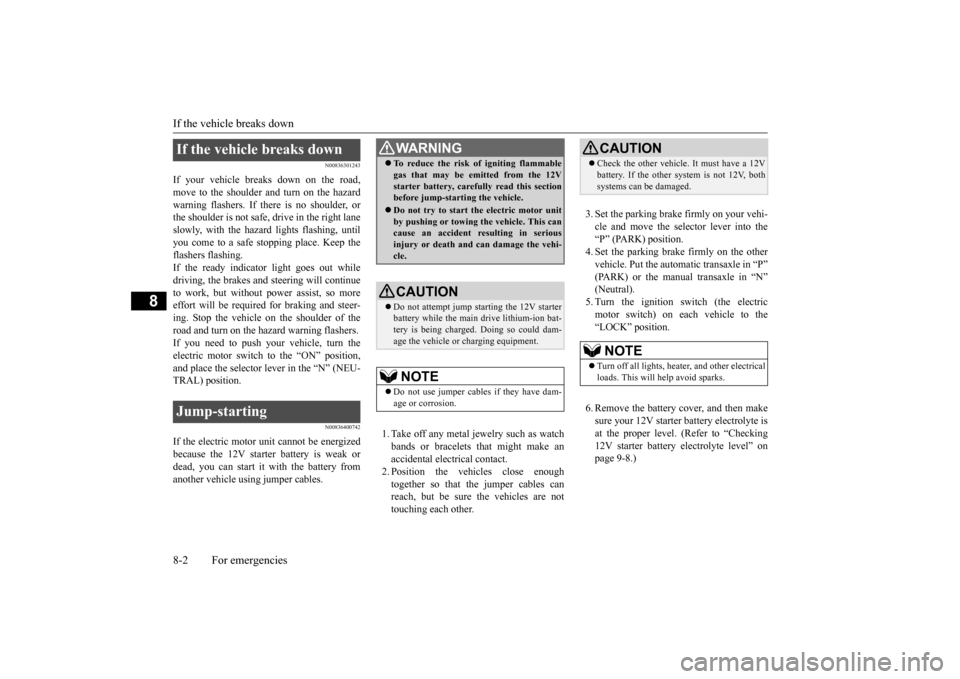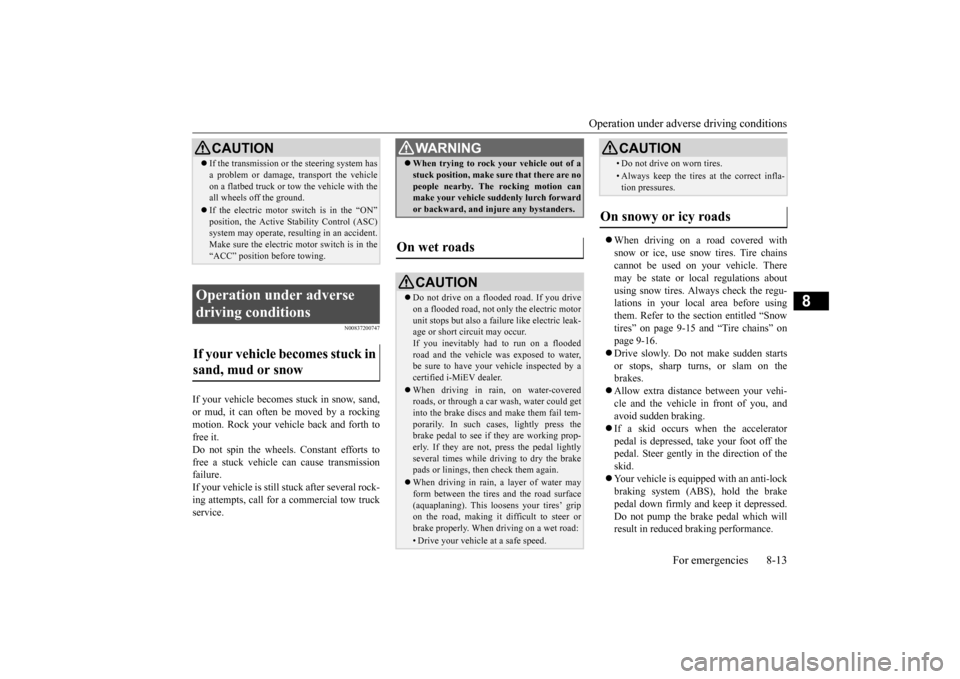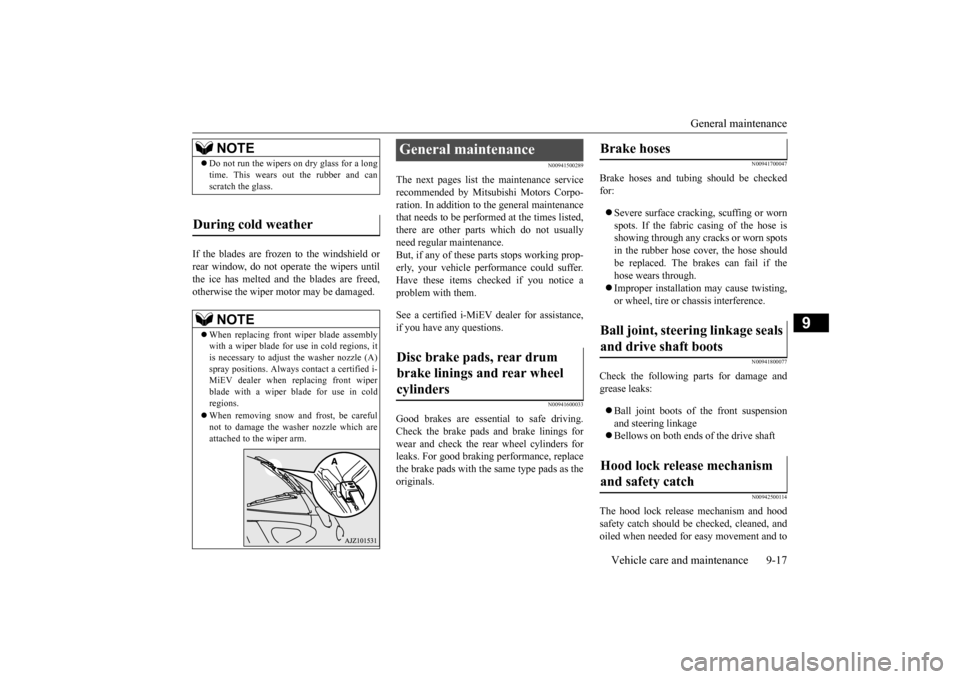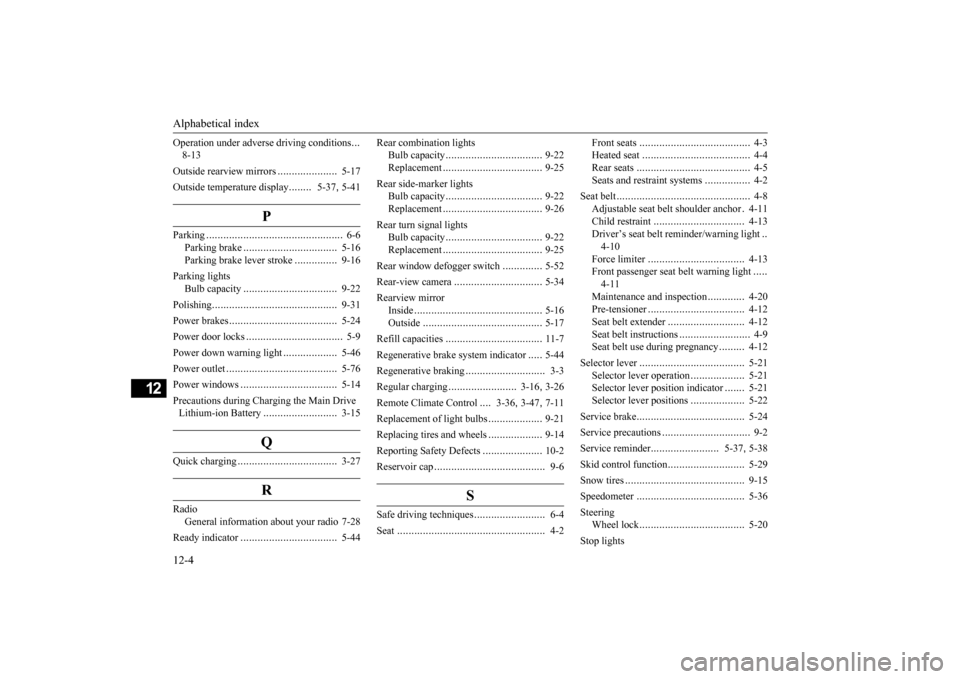2017 MITSUBISHI iMiEV brakes
[x] Cancel search: brakesPage 234 of 296

If the vehicle breaks down 8-2 For emergencies
8
N00836301243
If your vehicle breaks down on the road, move to the shoulder and turn on the hazard warning flashers. If there is no shoulder, orthe shoulder is not safe, drive in the right lane slowly, with the hazard lights flashing, until you come to a safe stopping place. Keep theflashers flashing. If the ready indicator light goes out while driving, the brakes a
nd steering will continue
to work, but without power assist, so more effort will be required
for braking and steer-
ing. Stop the vehicle on the shoulder of the road and turn on the hazard warning flashers. If you need to push your vehicle, turn theelectric motor switch to the “ON” position, and place the selector lever in the “N” (NEU- TRAL) position.
N00836400742
If the electric motor unit cannot be energizedbecause the 12V starter battery is weak ordead, you can start it with the battery from another vehicle using jumper cables.
1. Take off any metal jewelry such as watch bands or bracelets
that might make an
accidental electrical contact. 2. Position the vehi
cles close enough
together so that the jumper cables can reach, but be sure the vehicles are nottouching each other.
3. Set the parking brake firmly on your vehi- cle and move the selector lever into the “P” (PARK) position. 4. Set the parking brake firmly on the othervehicle. Put the automatic transaxle in “P”5. Turn the ignition switch (the electric motor switch) on each vehicle to the “LOCK” position. 6. Remove the battery
cover, and then make
sure your 12V starter
battery electrolyte is
at the proper level. (Refer to “Checking 12V starter battery electrolyte level” onpage 9-8.)
If the vehicle breaks down Jump-starting
WA R N I N G To reduce the risk of igniting flammable gas that may be em
itted from the 12V
starter battery, carefully read this sectionbefore jump-starting the vehicle. Do not try to start the electric motor unit by pushing or towing the vehicle. This can cause an accident re
sulting in serious
injury or death and
can damage the vehi-
cle.CAUTION Do not attempt jump st
arting the 12V starter
battery while the main
drive lithium-ion bat-
tery is being charged. Doing so could dam-age the vehicle or charging equipment.NOTE
Do not use jumper cables if they have dam- age or corrosion.
CAUTION Check the other vehicle.
It must have a 12V
battery. If the other system is not 12V, bothsystems can be damaged.NOTE
Turn off all lights, heat
er, and othe
r electrical
loads. This will
help avoid sparks.
BK0220401US.book 2 ページ 2015年6月3日 水曜日 午前7時42分
Page 237 of 296

Tire repair kit
For emergencies 8-5
8
If you drive your vehicle with a low battery charge, after the electric motor unit has beenstarted by using jumper
cables, it can cause
the anti-lock braking sy
stem warning light to
illuminate. This is only due to the low batteryvoltage. It is not a problem with the brake system. If this happens, fully charge the 12V starter battery and ensure the charging system is operating properly.
N00836600366
This vehicle is equipped
with a tire repair kit
which can be used to repair a minor puncture in tread area caused by
a nail, screw or simi-
lar object. A spare tire
is not provided with
this vehicle.
N00837701026
The tire repair kit is
stowed under the rear
seat cushion.
N00837800033
1. Pull forward the seat stoppers (A) underthe rear seat cushion (B). 2. Lift up the seat
cushion and pull it for-
ward to remove it. 3. Remove the screws (C) with a coin or the washer (D) at a position shown in the illustration, and re
move the cover (E).
As your vehicle has anti-lock brakes Tire repair kit
WA R N I N G The tire repair kit may not permanently seal a punctured tire. Using the tire repair
kit may damage the
wheel and/or the tire inflation pressuresensor for the tire. The vehicle must promptly be inspected and repaired by a certified i-MiEV dealer after using the tirerepair kit.
Use only the Mitsubishi genuine tire repair kit. Sealant in other repair kits maynot sufficiently seal the tire puncture.
Tire repair kit storage 1- Tire compressorWA R N I N G
2- Tire repair set: Items #3-#8 shown
above
3- Tire sealant bottle4- Filler hose 5- Valve insert (spare)7- Speed restriction sticker 8- Instruction manual for tire repairTo remove
BK0220401US.book 5 ページ 2015年6月3日 水曜日 午前7時42分
Page 245 of 296

Operation under adverse driving conditions
For emergencies 8-13
8
N00837200747
If your vehicle becomes stuck in snow, sand, or mud, it can often be moved by a rocking motion. Rock your vehicle back and forth tofree it. Do not spin the wheels. Constant efforts to free a stuck vehicle can cause transmissionfailure. If your vehicle is still
stuck after several rock-
ing attempts, call for a commercial tow truckservice.
When driving on a road covered with snow or ice, use snow tires. Tire chains cannot be used on your vehicle. Theremay be state or local regulations about using snow tires. Always check the regu- lations in your local area before usingthem. Refer to the section entitled “Snow tires” on page 9-15 and “Tire chains” on page 9-16. Drive slowly. Do not make sudden starts or stops, sharp turns, or slam on the brakes. Allow extra distance between your vehi- cle and the vehicle in front of you, and avoid sudden braking. If a skid occurs when the accelerator pedal is depressed, take your foot off the pedal. Steer gently in the direction of theskid. Your vehicle is equippe
d with an anti-lock
braking system (ABS), hold the brakepedal down firmly and
keep it depressed.
Do not pump the brake pedal which will result in reduced braking performance.
CAUTION If the transmission or the steering system has a problem or damage,
transport the vehicle
on a flatbed truck or to
w the vehicle with the
all wheels off the ground. If the electric motor switch is in the “ON”
lting in an accident.
Make sure the electric motor switch is in the“ACC” position before towing.
Operation under adverse driving conditions If your vehicle becomes stuck in sand, mud or snow
WA R N I N G When trying to rock
your vehicle out of a
stuck position, make sure that there are nopeople nearby. The
rocking motion can
make your vehicle suddenly lurch forward or backward, and inju
re any bystanders.
On wet roads
CAUTIONDo not drive on a flooded road. If you drive on a flooded road, not only the electric motorunit stops but also a fail
ure like electric leak-
age or short circuit may occur. If you inevitably had to run on a floodedroad and the vehicle was exposed to water, be sure to have your vehicle inspected by a certified i-MiEV dealer. When driving in rain, on water-covered roads, or through a car wash, water could getinto the brake discs and make them fail tem- porarily. In such cases, lightly press the brake pedal to see if they are working prop-erly. If they are not, press the pedal lightlyseveral times while driv
ing to dry the brake
pads or linings, then check them again. When driving in rain, a layer of water may form between the tires and the road surface (aquaplaning). This l
oosens your tires’ grip
on the road, making it difficult to steer or brake properly. When driving on a wet road:• Drive your vehicle at a safe speed.
• Do not drive on worn tires.• Always keep the tires at the correct infla- tion pressures.
On snowy or icy roads
CAUTION
BK0220401US.book 13 ページ 2015年6月3日 水曜日 午前7時42分
Page 263 of 296

General maintenance
Vehicle care and maintenance 9-17
9
If the blades are frozen to the windshield or rear window, do not operate the wipers until the ice has melted and the blades are freed,otherwise the wiper mo
tor may be damaged.
N00941500289
The next pages list th
e maintenance service
recommended by Mitsubishi Motors Corpo- ration. In addition to the general maintenancethat needs to be performed at the times listed, there are other parts which do not usually need regular maintenance.But, if any of these parts stops working prop- erly, your vehicle performance could suffer. Have these items checked if you notice a problem with them. See a certified i-MiEV dealer for assistance, if you have any questions.
N00941600033
Good brakes are essential to safe driving. Check the brake pads and brake linings for wear and check the rear wheel cylinders forleaks. For good braking performance, replace the brake pads with the same type pads as the originals.
N00941700047
Brake hoses and tubing should be checked for: Severe surface cracki
ng, scuffing or worn
spots. If the fabric casing of the hose isshowing through any cracks or worn spots in the rubber hose cover, the hose should be replaced. The brakes can fail if the hose wears through. Improper installation may cause twisting, or wheel, tire or
chassis interference.
N00941800077
Check the following parts for damage and grease leaks: Ball joint boots of the front suspension and steering linkage Bellows on both ends of the drive shaft
N00942500114
The hood lock release mechanism and hood safety catch should be
checked, cleaned, and
oiled when needed for easy movement and to
NOTE
Do not run the wipers on dry glass for a long time. This wears out the rubber and canscratch the glass.
During cold weather
NOTE
When replacing front wiper blade assembly with a wiper blade for use in cold regions, it is necessary to adjust the washer nozzle (A)
contact a certified i-
MiEV dealer when re
placing front wiper
blade with a wiper blade for use in cold regions. When removing snow and frost, be careful not to damage the wash
er nozzle which are
attached to the wiper arm.
General maintenance Disc brake pads, rear drum brake linings and rear wheel cylinders
Brake hoses Ball joint, steering linkage seals and drive shaft boots Hood lock release mechanism and safety catch
BK0220401US.book 17 ページ 2015年6月3日 水曜日 午前7時42分
Page 291 of 296

Alphabetical index
12-1
12
Numerics
12V power outlet
................................
5-76
12V starter battery
................................
9-7
Specification
..................................
11-6
12V starter battery charging system warning light
.................................................
5-45
A
Accessory (installation)
.........................
3-7
Acoustic vehicle alerting system (AVAS)
....
5-23 Active stability control
........................
5-28
ASC indicator
.................................
5-30
ASC OFF indicator
.........................
5-30
ASC OFF switch
............................
5-29
Skid control function
.......................
5-29
Traction control function
.................
5-29
Air conditioning
...................................
7-4
Important air condi
tioning operating tips
..
7-10
Air purifier
.........................................
7-11
Aluminum wheels
...............................
9-32
Antenna
.............................................
7-27
Anti-lock braking system
.....................
5-25
Warning light
........................
5-26
, 5-27
ASC
..................................................
5-28
ASC indicator
.....................................
5-30
ASC OFF indicator
.............................
5-30
ASC OFF switch
................................
5-29
Assist grip
.........................................
5-81
Audio
AM/FM electronicall
y tuned radio with
CD player
....................................
7-11
Error codes
....................................
7-24
Handling of compact discs
..............
7-25
Steering wheel audio re
mote control switch
7-22
B
Back up lights
Bulb capacity
.................................
9-22
Replacement
..................................
9-25
Ball joint, steering li
nkage seals and drive
shaft boots
.......................................
9-17
Battery
12V starter battery charging system warn- ing light
.......................................
5-45
Disconnection and connection
...........
9-9
During cold weather
.........................
9-9
Main drive lithium-ion battery
...........
3-3
Bluetooth® 2.0 interface
.....................
5-53
Brake
Anti-lock braking system
................
5-25
Braking
...........................................
6-5
Fluid
.......................................
9-7
, 11-7
Hose
.............................................
9-17
Parking brake
.................................
5-16
Parking brake lever stroke
...............
9-16
Pedal
.............................................
5-24
Pedal free play
................................
9-16
Power brakes
..................................
5-24
Service brake
..................................
5-24
Warning light
.................................
5-44
Brake assist system
.............................
5-25
Break-in recommendations
....................
5-2
Bulb capacity
......................................
9-22
C
California Perchl
orate Materials
Requirements
.....................................
3-8
Capacities
..........................................
11-7
Card holder
...............................
5-76
, 5-80
Cargo loads
........................................
6-10
Certification label
...............................
11-3
Charging
Quick charging
...............................
3-27
Regular charging
...................
3-16
, 3-26
Charging indicator
..............................
5-44
Charging Timer
..................................
3-41
Charging troubleshooting guide
............
3-31
Chassis number
...................................
11-2
Child restraint
.....................................
4-13
Child safety locks for rear door
............
5-10
Cleaning
BK0220401US.book 1 ページ 2015年6月3日 水曜日 午前7時42分
Page 294 of 296

Alphabetical index 12-4
12
Operation under adverse driving conditions
...
8-13 Outside rearview mirrors
.....................
5-17
Outside temperature display
........
5-37
, 5-41
P
Parking
................................................
6-6
Parking brake
.................................
5-16
Parking brake lever stroke
...............
9-16
Parking lights
Bulb capacity
.................................
9-22
Polishing
............................................
9-31
Power brakes
......................................
5-24
Power door locks
..................................
5-9
Power down warning light
...................
5-46
Power outlet
.......................................
5-76
Power windows
..................................
5-14
Precautions during Charging the Main Drive Lithium-ion Battery
..........................
3-15
Q
Quick charging
...................................
3-27
R
Radio
General information about your radio 7-28
Ready indicator
..................................
5-44
Rear combination lights
Bulb capacity
..................................
9-22
Replacement
...................................
9-25
Rear side-marker lights
Bulb capacity
..................................
9-22
Replacement
...................................
9-26
Rear turn signal lights
Bulb capacity
..................................
9-22
Replacement
...................................
9-25
Rear window defogger switch
..............
5-52
Rear-view camera
...............................
5-34
Rearview mirror
Inside
.............................................
5-16
Outside
..........................................
5-17
Refill capacities
..................................
11-7
Regenerative brake system indicator
.....
5-44
Regenerative braking
............................
3-3
Regular charging
........................
3-16
, 3-26
Remote Climate Control
....
3-36
, 3-47
, 7-11
Replacement of light bulbs
...................
9-21
Replacing tires and wheels
...................
9-14
Reporting Safety Defects
.....................
10-2
Reservoir cap
.......................................
9-6
S
Safe driving techniques
.........................
6-4
Seat
....................................................
4-2
Front seats
.......................................
4-3
Heated seat
......................................
4-4
Rear seats
........................................
4-5
Seats and restraint systems
................
4-2
Seat belt
...............................................
4-8
Adjustable seat belt shoulder anchor
.4-11
Child restraint
................................
4-13
Driver’s seat belt
reminder/warning light
..
4-10 Force limiter
..................................
4-13
Front passenger seat belt warning light
.....
4-11 Maintenance and inspection
.............
4-20
Pre-tensioner
..................................
4-12
Seat belt extender
...........................
4-12
Seat belt
instructions
.........................
4-9
Seat belt use
during pregnancy
.........
4-12
Selector lever
.....................................
5-21
Selector lever operation
...................
5-21
Selector lever po
sition indicator
.......
5-21
Selector le
ver positions
...................
5-22
Service brake
......................................
5-24
Service precautions
...............................
9-2
Service reminder
........................
5-37
, 5-38
Skid control function
...........................
5-29
Snow tires
..........................................
9-15
Speedometer
......................................
5-36
Steering
Wheel lock
.....................................
5-20
Stop lights
BK0220401US.book 4 ページ 2015年6月3日 水曜日 午前7時42分